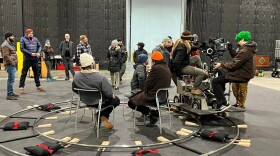A gold-beaded TY Beanie Baby bear is displayed behind glass at the entrance to "This is Native Land," a permanent exhibition that opened this month at the Washington State History Museum.
Long strands of human hair attached to the crown of the bear's head wrap around the front of the platform.
Beanie Babies were popular plush toys in the 1990s and early 2000s. They were meant for young children but became expensive collectibles for adults.
The piece, Millennium Dreams, is from Tlingit artist Alison Bremner.
It sets the stage for the rest of the exhibition, according to MaryMikel Stump, the museum's director of audience engagement. Stump said Bremner is comparing "museums’ voracious appetite" for Native artifacts to what happened with the toys.
“These things are now not available to the people for whom they were actually made to be used,” Stump said.
"This is Native Land" is not an artifact-rich exhibition. Rather, it uses contemporary art from more than 100 Native contributors to explore the history of Washington state from their perspective. It confronts historic and present challenges faced by Native people while centering resilience, joy and cultural revitalization.
The exhibition is divided into three teachings: “We are of the land and waters”; "With knowledge comes responsibility”; and “Our sovereignty protects the people, the lands, and the waters.” Each section has a color scheme — blue, purple or green. Primary source documents displayed on black structures talk about actions taken by government entities that harmed tribes.
Other pieces include a powwow drum, beaded medical equipment such as a stethoscope, and engraved handcuffs that were forged from an original pair used on children in boarding schools. The items were either commissioned by the museum or donated by the artists for the exhibition.
Stump said the museum heavily relied on Native curators, as well as a Native advisory council, to guide the work. Everything presented there can be found in primary source documents.
“We promised that we would tell the truth, and sometimes the truth is hard. And history, if it always makes you feel good, then it's nostalgia," Stump said. "We're not in the business of nostalgia.”
Many perspectives
Todd Clark of the Wailaki-Round Valley Indian Tribes and Danica Sterud Miller of the Puyallup Tribe of Indians curated the show. They included voices and perspectives from more than 60 tribes.
“This exhibition creates spaces for Natives, tribes and citizens to tell their own stories and centers their experiences,” Sterud Miller said.
According to Clark, the museum gave the curators and advisory council the power to direct the narrative behind the exhibition.
"It feels a bit like we've broken a little bit of ground and kind of opened up a different story here,” he said.
Museums have historically told the state’s history through the lens of settlers, Clark said, and this work enhances that history, providing “the rest of the story.”
“Tribal history is Washington state history. And that was one of the things I really wanted to push in this exhibition,” he said. “You can’t understand the state history without understanding this tribal history.”
Treaties informed their work as well. The land tribal leaders signed over in treaties with the federal government eventually led to statehood. In securing the treaties, Clark said, those leaders protected the tribes' sovereign rights, such as the right to fish in their “usual and accustomed places.”
"Our tribal leaders were really saying, ‘This is going to enable us to be here forever,’ and it was that important,” Clark said. “And that’s why I really want to stress the importance of those treaties, because they did that for us.”
Clark feels like the exhibit strikes the right balance of joy and the adversity that Native people continue to face.
“I think that’s kind of how it is in real life for us. Right?” he said. “Like, we deal with all these traumas and we deal with the boarding school. But if you go to a canoe journey or a powwow or any ceremony, there is still a lot of joy and life that you get out of being with the Native communities.”









